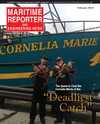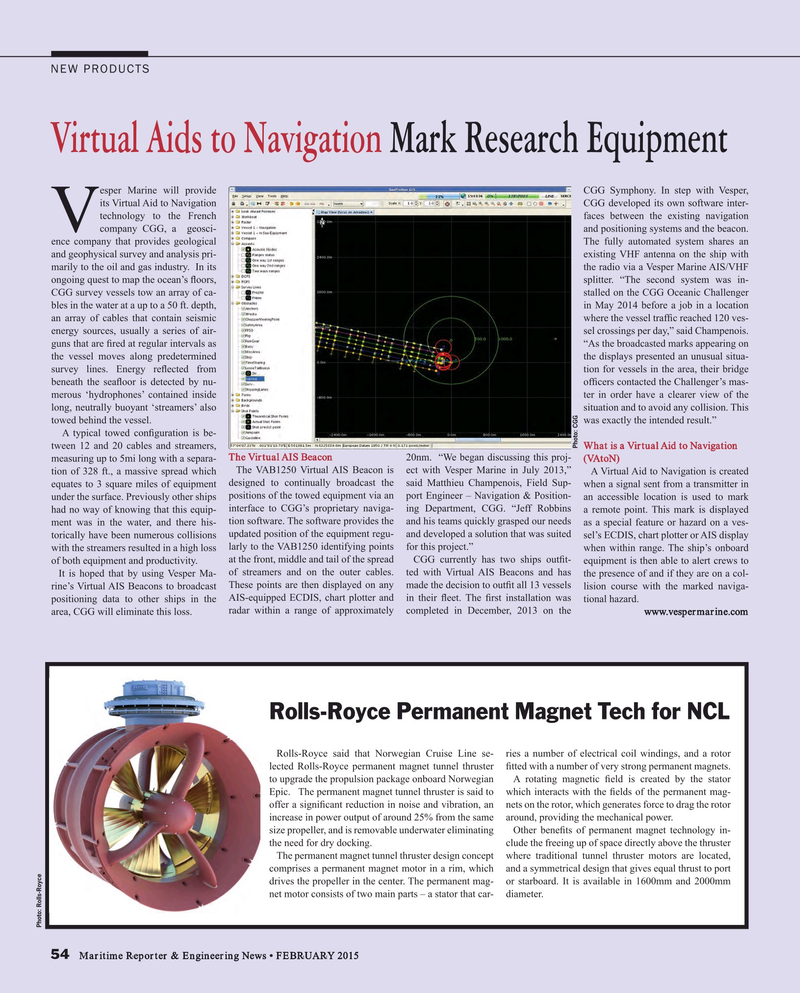
Page 54: of Maritime Reporter Magazine (February 2015)
Cruise Shipping Edition
Read this page in Pdf, Flash or Html5 edition of February 2015 Maritime Reporter Magazine
NEW PRODUCTS
Virtual Aids to Navigation Mark Research Equipment esper Marine will provide CGG Symphony. In step with Vesper, its Virtual Aid to Navigation CGG developed its own software inter- technology to the French faces between the existing navigation
Vcompany CGG, a geosci- and positioning systems and the beacon. ence company that provides geological The fully automated system shares an and geophysical survey and analysis pri- existing VHF antenna on the ship with marily to the oil and gas industry. In its the radio via a Vesper Marine AIS/VHF ongoing quest to map the ocean’s ? oors, splitter. “The second system was in-
CGG survey vessels tow an array of ca- stalled on the CGG Oceanic Challenger bles in the water at a up to a 50 ft. depth, in May 2014 before a job in a location an array of cables that contain seismic where the vessel traf? c reached 120 ves- energy sources, usually a series of air- sel crossings per day,” said Champenois. guns that are ? red at regular intervals as “As the broadcasted marks appearing on the vessel moves along predetermined the displays presented an unusual situa- survey lines. Energy re? ected from tion for vessels in the area, their bridge beneath the sea? oor is detected by nu- of? cers contacted the Challenger’s mas- merous ‘hydrophones’ contained inside ter in order have a clearer view of the long, neutrally buoyant ‘streamers’ also situation and to avoid any collision. This towed behind the vessel. was exactly the intended result.” A typical towed con? guration is be-
Photo: CGG tween 12 and 20 cables and streamers, What is a Virtual Aid to Navigation
The Virtual AIS Beacon 20nm. “We began discussing this proj- measuring up to 5mi long with a separa- (VAtoN)
The VAB1250 Virtual AIS Beacon is ect with Vesper Marine in July 2013,” tion of 328 ft., a massive spread which A Virtual Aid to Navigation is created equates to 3 square miles of equipment designed to continually broadcast the said Matthieu Champenois, Field Sup- when a signal sent from a transmitter in under the surface. Previously other ships positions of the towed equipment via an port Engineer – Navigation & Position- an accessible location is used to mark interface to CGG’s proprietary naviga- had no way of knowing that this equip- ing Department, CGG. “Jeff Robbins a remote point. This mark is displayed ment was in the water, and there his- tion software. The software provides the and his teams quickly grasped our needs as a special feature or hazard on a ves- and developed a solution that was suited sel’s ECDIS, chart plotter or AIS display torically have been numerous collisions updated position of the equipment regu- with the streamers resulted in a high loss larly to the VAB1250 identifying points for this project.” when within range. The ship’s onboard at the front, middle and tail of the spread CGG currently has two ships out? t- of both equipment and productivity. equipment is then able to alert crews to
It is hoped that by using Vesper Ma- of streamers and on the outer cables. ted with Virtual AIS Beacons and has the presence of and if they are on a col- rine’s Virtual AIS Beacons to broadcast These points are then displayed on any made the decision to out? t all 13 vessels lision course with the marked naviga- positioning data to other ships in the AIS-equipped ECDIS, chart plotter and in their ? eet. The ? rst installation was tional hazard.
radar within a range of approximately completed in December, 2013 on the area, CGG will eliminate this loss. www.vespermarine.com
Rolls-Royce Permanent Magnet Tech for NCL
Rolls-Royce said that Norwegian Cruise Line se- ries a number of electrical coil windings, and a rotor lected Rolls-Royce permanent magnet tunnel thruster ? tted with a number of very strong permanent magnets. to upgrade the propulsion package onboard Norwegian A rotating magnetic ? eld is created by the stator
Epic. The permanent magnet tunnel thruster is said to which interacts with the ? elds of the permanent mag- offer a signi? cant reduction in noise and vibration, an nets on the rotor, which generates force to drag the rotor increase in power output of around 25% from the same around, providing the mechanical power. size propeller, and is removable underwater eliminating Other bene? ts of permanent magnet technology in- the need for dry docking. clude the freeing up of space directly above the thruster
The permanent magnet tunnel thruster design concept where traditional tunnel thruster motors are located, comprises a permanent magnet motor in a rim, which and a symmetrical design that gives equal thrust to port drives the propeller in the center. The permanent mag- or starboard. It is available in 1600mm and 2000mm net motor consists of two main parts – a stator that car- diameter.
Photo: Rolls-Royce 54 Maritime Reporter & Engineering News • FEBRUARY 2015
MR #2 (50-58).indd 54 MR #2 (50-58).indd 54 2/6/2015 10:40:57 AM2/6/2015 10:40:57 AM

 53
53

 55
55
